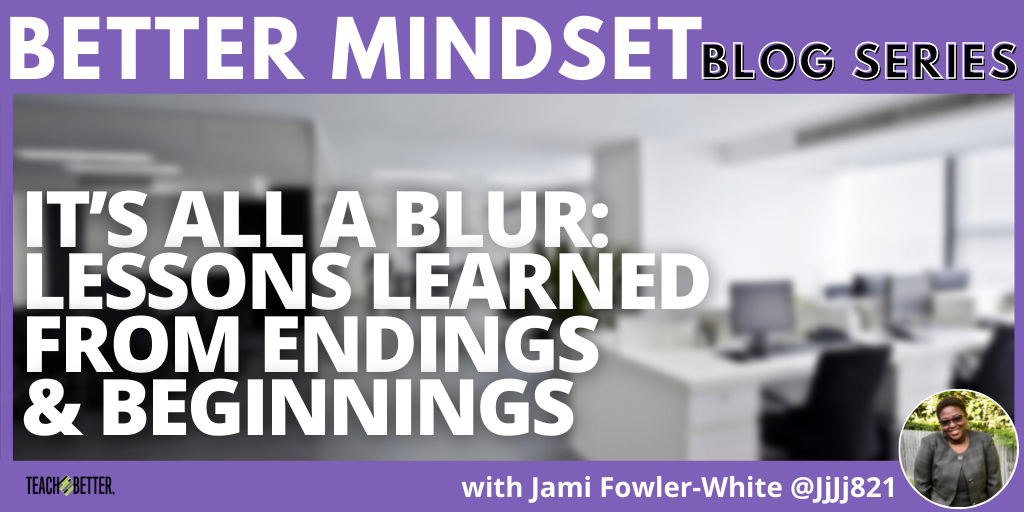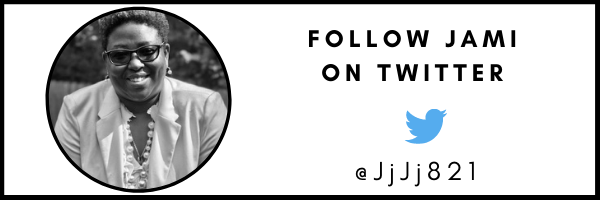
Photo Credit: DepositPhotos.com
TL;DR:
- Reflect on the lessons learned from the endings and beginnings you experience.
- To prevent the blur, reflect on the beginning and identify what you learned at the end. Create concrete ways to apply those lessons.
How often do you reflect on your life, instructional practice, or progress towards accomplishing goals? Do you wait until it’s time to create resolutions for the new year, or do you have a set routine to ensure you take a look back at your experiences?
For me, I have been attempting to create some type of schedule for reviewing my progress towards personal and professional goals on a monthly basis.
Why, you might ask…because when I do not look back regularly, I am subject to forget just how far I have come. Forgetting all of your accomplishments, no matter how small, can prevent you from maintaining a positive outlook even in the best of times.
So here goes. Let’s take a look back at the 2020-2021 school year….
This school year, I have been amazed at the community outreach that has manifested to ensure that our children were able to continue learning. We will forever be grateful to churches who opened their doors to ensure our children had meals, to community centers that offered childcare to essential workers despite the risks, and we cannot forget those grandparents, aunts, uncles, and neighbors who rearranged their lives to provide kids with stable environments to learn amid full-time, part-time, and intermittent school closures.
Viewpoints regarding what schooling should look like will forever be changed. As we emerge from the isolated pods of protection we formed over the last year, we begin to shape what will be looked at as normal for years to come.
To prevent the blur, reflect on the beginning, identify what you learned at the end, and then create concrete ways to apply those lessons as you begin the cycle all over again. Click To TweetLessons Learned #1: Our Foundation Matters
Welcome to Kindergarten…
I recently observed one of my Kindergarten classes. During my time, I watched the teacher and students use number cubes to group items by ten and add the Ten Way. The lesson began beautifully. The teacher placed visuals on the screen and the students easily counted and verbally gave the teacher the answers perfectly. I must admit. I was ecstatic at the progress our youngest learners had made despite attending their first year of school via a computer screen.
To my surprise, though, the lesson took an unusual turn…
The teacher asked students to take out their dry-erase boards or turn to a clean page in their journals. The teacher modeled using two different color crayons. Students were instructed to use one color to create their group of ten and the other to draw the number of ones. Students were able to tell the teacher exactly what she needed to do to represent the numbers 11, 14, and 13. I was sure they were ready to work on their own and excitedly awaited the teacher asking the students to hold their work up to the screen to show the number 12.
I was utterly shocked and stunned when the students were unable to transfer this oral knowledge to print. The students could critique their peers’ papers and tell them that they only had one cube instead of two individual cubes added to their group of ten, but none were able to correctly draw a visual for the number 12. I watched as this wonderful educator offered several alternatives for students as she serviced both her in-person and virtual learners.
As I watched, I realized that our foundations matter.
At first glance, everything appeared to be perfect. On the surface, those outside of the educational field believed that decreasing the digital divide would be the missing piece to increasing academic achievement in schools. In reality, all of the pieces were already there. The missing piece was not one that cost money at all. The truth is when students are not making adequate progress, we should go back to the beginning and look for the cracks in their academic foundation. If we don’t take the time to fill in the cracks, they will widen as students progress through the grades and eventually result in a fracture or complete break.
Fracture or Breaks in Students’ Academic Foundation
These fractures and breaks in student’s foundations revealed themselves as…
Access is not equity.
We quickly found out that having an electronic device and knowing how to use one were not the same thing. Access is not equity when children and parents have not been taught how to use the software and/or device. Our students who had learned problem-solving and research skills were able to troubleshoot tech troubles on their own. Those without often checked out and were lost to the “my device does not work” never-ending saga.
How many of your students flourished in the tech-savvy world? What were your methods for allowing students to share and support others? Let’s face it! Technology is here to stay. Solving problems and researching are skills our students really need to master. We don’t know what the future holds. These basic skills are essential and critical to them being able to adapt, adjust, and keep the world moving forward.
Time may not be on our side.
Dominating the clock brought about a newfound respect for time. Students learned that even the simplest of tasks took much longer than they used to. Would they keep working and persevere or succumb to the time monster and turn in nothing at all? The answer depended on their history regarding how to respond when confronted with an obstacle, barrier, or whether they had been taught how to study at all. How did you ensure students persevered through challenges prior to the pandemic?
Students who had been taught to have a growth mindset continued until each task was complete. Those who had not been taught fell prey to their fixed mindset triggers and fumbled. This lesson was hard, but now we know that mental attitude is something that is crucial for students to master. We want every student to reach their full potential and so many did not this year. Let’s make promoting a growth mindset a priority and it will help our kids persevere.
What is happening at home?
Although few will admit it, the home learning atmosphere presented more challenges than we knew were possible. As the adults in their world continued to cope with the ever-changing world outside, children were expected to go on as if the pandemic had never happened. Due to mandates that were bigger than just you and me, we gave classwork, projects, and homework without even blinking to consider the challenges they might impose on our students and their families who were barely holding on.
The lesson here is so profound and one that really isn’t new. Children thrive when their parents partner with the school. This year more than ever it was critical to collaborate with parents, offer grace, and support. All three are vital for children achieving academic success. What strategies did you offer parents to support learning at home?
Lessons Learned #2: Technology is just a tool. Are you tech-savvy?
Figuring out where I fit in was a very daunting task. As I worked my way through the pandemic maze, I struggled to find the consistency I craved. Surely, I could assist with technology, I thought. Now, if anyone had asked me before last March if I was tech-savvy, I would have given them an unequivocal answer of yes. Boy was I wrong!
Don’t tell anyone this, but I want you to know that I have never studied so hard in my life. When I realized just how much I didn’t know, it was like being a hamster on its wheel. Constantly running faster and faster while I spent my day in online sessions stretching myself to the limit to increase my knowledge so that I could be of assistance to everyone around me.
As we learned with my Kindergarten example, technology is just a tool. Teaching and learning require a back-to-the-basics approach. It doesn’t matter if you have mastered the latest tech tools. Our job is to educate students, and this requires only the simplest of tools. When her students began to struggle, Mrs. T. turned off her PowerPoint, opened up her document camera, and began teaching using a composition book and two crayons.
In that moment, I was so excited that I wanted to stand up and clap for her. There is nothing like a back-to-the-basics approach! On any given day, when your tech gives you the blues, simply take out a marker and small dry-erase board and do what you know to do. Our students need knowledge, and this is what you innately share. Go ahead, teach your heart out. Our kids are counting on you.
Lessons Learned #3: The Emotional Rollercoaster
Maslow was right. If there was only one lesson to learn this school year, it was that learning cannot take place until basic human needs have been met. It’s important to remember that this includes our needs too. Until we attend to our own self-care, we cannot take care of others. “Life does not come with a built in GPS system. Our emotions which range from uncontrollable anger to passionate feelings of love are what our bodies use to send instantaneous alerts and signal changes within our world” (Fowler-White, 2021, p. 105).
This year, I found out that the emotional rollercoaster was real. Those feelings of doubt that used to only creep in every once in a while, came in fast and furious more often than not. Figuring out how to regulate my own emotional winding road was the first step in my journey to advocate for social and emotional (SEL) strategies, such as check-ins embedded within points throughout the day. If you think these practices should change when we all return to our buildings next year, our students will need more, not less, of SEL to help them put words to how they feel.
[scroll down to keep reading] Lessons Learned #4: Connections Create Safety Nets
Lessons Learned #4: Connections Create Safety Nets
The last lesson learned is the simplest things make the biggest difference. As my district moved to hybrid instruction in February, I went through an internal debate between whether to retreat because I was being cautious or to try to create calmness through connections.
Well, I chose the latter which led me to taking long walks in the morning. No, not the one you are thinking. This long walk consisted of visiting and talking to every person within my school building each and every day. I wanted to wave at students and make sure that teacher and staff needs were being met. Checking in helped me know that everyone was doing okay.
The truth is I need these walks as much as my students and staff. We all need to feel connected. It creates a sort of safety net for us to thrive and make our way. What types of ways have you intentionally connected with students and colleagues this year? If you are ever feeling disconnected, I suggest you begin here. Authentic relationships help us empathize and support one another.
How will you prevent the blur?
Now, these were not the only lessons learned throughout this school year, but they were the most important from my year-long journey. As we end and plan new beginnings, I encourage each of you to take time to stop and think about the lessons you learned. I know it was all a blur…that’s why I am challenging you to put them down on paper. Create a list of between 3-5 that you deem important. Share them with colleagues and formulate a plan to embed these practices into your routine daily.
You’ve seen my list and I have been working with colleagues to formulate a plan to identify the cracks in our students’ academic foundation, to remember to go back to the basic building blocks of teaching and learning, to embed SEL throughout the school day, and to create safety nets through connections.
I’m reminded of a quote by an unknown author which says, “the past is where you learned the lesson, the future is where you apply what you have learned.” To prevent the blur, reflect on the beginning, identify what you learned at the end, and then create concrete ways to apply those lessons as you begin the cycle all over again. As you prepare to begin your new cycle, remember that mindset is what matters most. Continue to focus on keeping a positive outlook. Above all, try to view every accumulated experience as an opportunity to assess where you are, grow, and “teach better.”
References/Resources:
Defining Moments, Mindset, and Moving Forward
Educators are Hybrid Heroes: Learn to Trust Your Instincts
Educator Reflection Tips, Volume II, Refining Our Practice
Life Doesn’t Come with GPS: Will You Sink or Sail?
When You Are at a Crossroad, Mindset Matters
About Jami Fowler-White
Jami Fowler-White is the CEO of Digital PD 4 You, LLC. Over the past two decades, she has served in many capacities in education which include ten years as a classroom teacher, an Instructional Coach, and a Core Advocate with Achieve the Core. She currently mentors First-time and Renewal candidates for the National Board and is a charter member of the National Board Network of Minoritized Educators and Black Women Education Leaders, Incorporated.
Additionally, Mrs. Fowler-White is also a proud member of Delta Sigma Theta Sorority and currently serves as an assistant principal in Shelby County Schools (TN). Fowler-White also provides professional development under the umbrella of the National Board and Digital PD 4 You for schools and districts.
She is the author/coauthor of several books including, Educator Reflection Tips, Volume #1, EduMatch’s Snapshots in Education 2020: Remote Learning Edition, The Skin You are In: Colorism in the Black Community, 2nd Edition, and Educator Reflection Tips, Volume II: Refining our Practice.
Jami blogs at DigitalPD4You.com , has a bi-monthly leadership blog on Insight Advance, and writes a monthly blog entitled the Better Mindset on TeachBetter.com She can be contacted via email at: jwhite.nbct2008@gmail.com and invites you to connect with her on Twitter via @JjJj821




